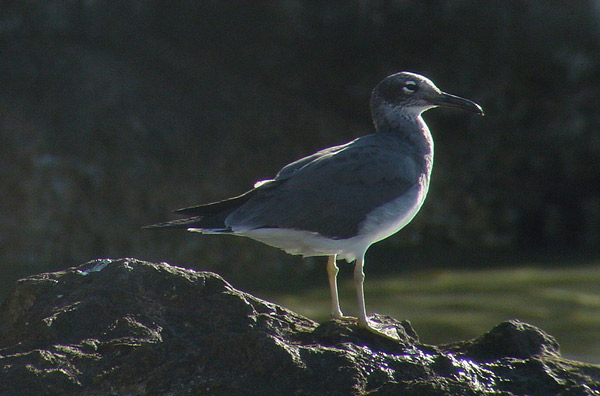 White-eyed Gull (L. leucophthalmus)
& Sooty Gull (L. hemprichii)
White-eyed Gull (L. leucophthalmus)
& Sooty Gull (L. hemprichii)
(last update:
White-eyed Gull L. leucophthalmus 3CY, February 20 2002, Shark Bay - Sharm El Sheik, S Sinai, Egypt.
Note the long, thin and slim bill, appearing all dark from
a distance and clearly lacking the two-toned billed of Sooty Gull. White-eyed
Gull is smaller in size and especially more elegantly build; lacking the high
breast and strong neck of Sooty Gull. It has
two white crescents in all plumages and especially the upper crescent is very
obvious, while this is only a small crescent in Sooty Gull. The lower
crescent is completely lacking in most Sooty Gulls.
In second winter, White-eyed Gull develops a blackish mask, extending on the
ear-coverts. Second winter Sooty Gull is less contrastingly patterned on the
head, more equally coloured brown and lacks the pure black feathers on the head
in all plumages. White-eyed Gull appears more greyish on the
upper-parts, where Sooty gull is brownish. By
February (late winter) the bill colour is still the most obvious difference
between White-eyed Gull and Sooty Gull: clearly two-toned in Sooty Gull and
appearing all dark in White-eyed Gull (though with a slightly paler brownish base on the lower
mandible).
Second winter birds show more white in the tail than first winter birds (which
have complete dark tails) and they often show a broken tail-band. Some feathers appear all
white, some have a black basal centre. The amount of black may be related to
timing of moult of a particular feather. Second winter birds resemble adults but lack the complete
white tail and the hood is not fully developed, the chin and forehead still
white or peppered.
The pointed juvenile primaries have been replaced for black second generation
feathers with rounded tips. The
tertials and wing-coverts have been moulted to plain grey feathers. The scapulars and mantle
feathers generally have the same grey colour as the coverts but the upper
scapulars show darker centres. The rump is dull grey, not clean white as in full adult plumage. The
breast-band is not plain grey but has some maculation on the throat, side-neck
extending to the nape. The legs are dull yellow.
